Abstract
In situ hybridisation has been used to detect mRNAs to the macrophage secretory products, lysozyme, interleukin 1 beta and tumour necrosis factor-alpha. Sections of paraformaldehyde fixed, frozen colonoscopic biopsies from patients with ulcerative colitis, Crohn's disease or normal controls were hybridised with specific radiolabelled probes and the signal detected by autoradiography. Lysozyme mRNA expression was more common in ulcerative colitis (22/27) and Crohn's disease (eight of eight) compared with controls (17/27). Positive cells were found mainly in the subepithelial region in normal colon, while in inflammatory bowel disease they also appeared in the deeper lamina propria. Immunocytochemistry in parallel sections showed that lysozyme mRNA was expressed only in macrophages or in metaplastic Paneth cells in longstanding inflammatory bowel disease. Tissue neutrophils did not express the lysozyme mRNA, though they have large stores of the protein. Tumour necrosis factor mRNA was detected in four of nine controls compared with 11/15 inflammatory bowel disease patients. For interleukin 1 beta, three of eight controls were positive compared with 10/13 with ulcerative colitis. The tumour necrosis factor signal was located mainly in the deeper lamina propria whereas the interleukin 1 beta was seen in subepithelial macrophages. These results confirm increased macrophage activation in inflammatory bowel disease and suggest functional heterogeneity within the intestinal macrophage population.
Full text
PDF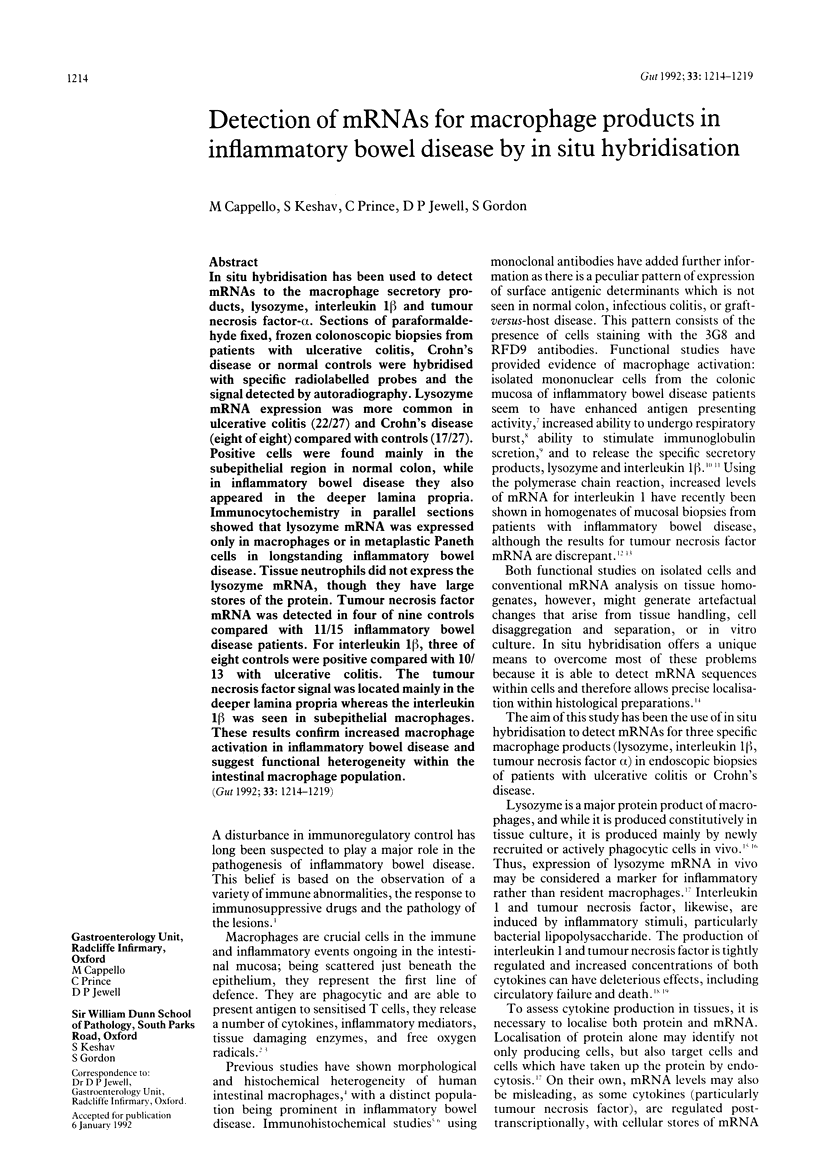
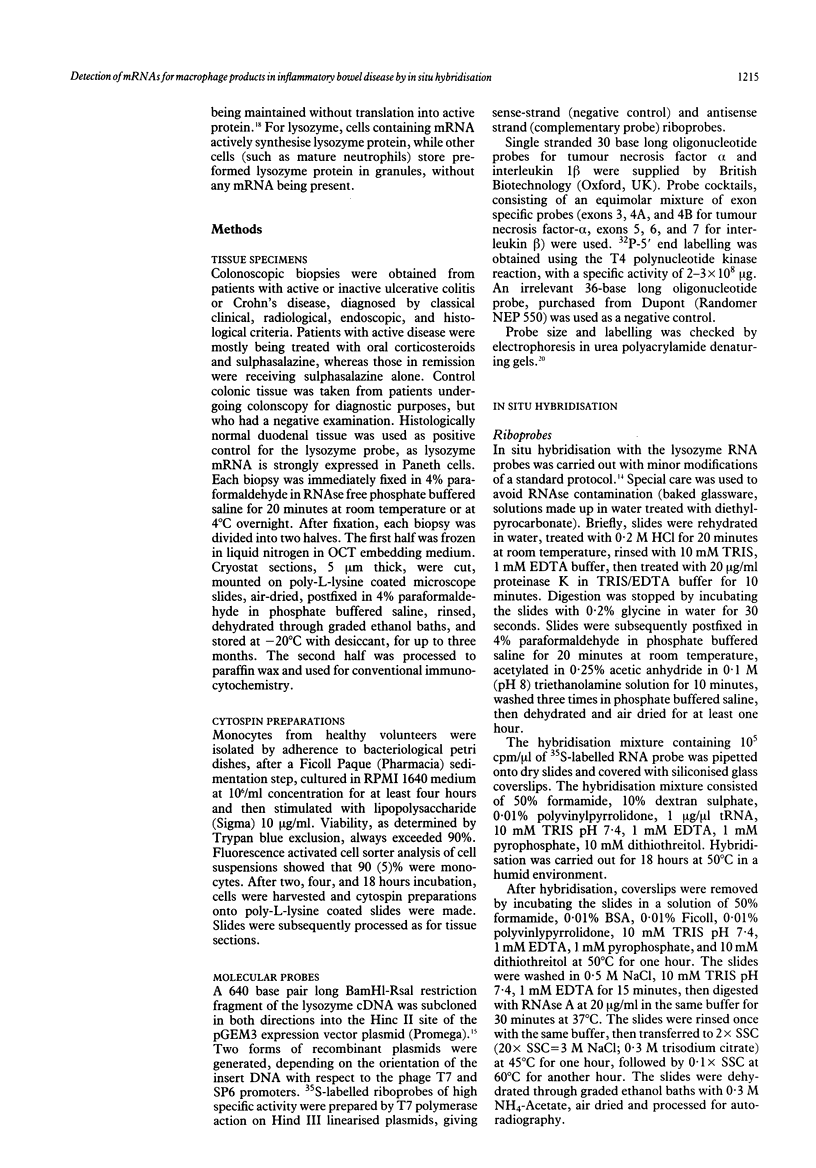
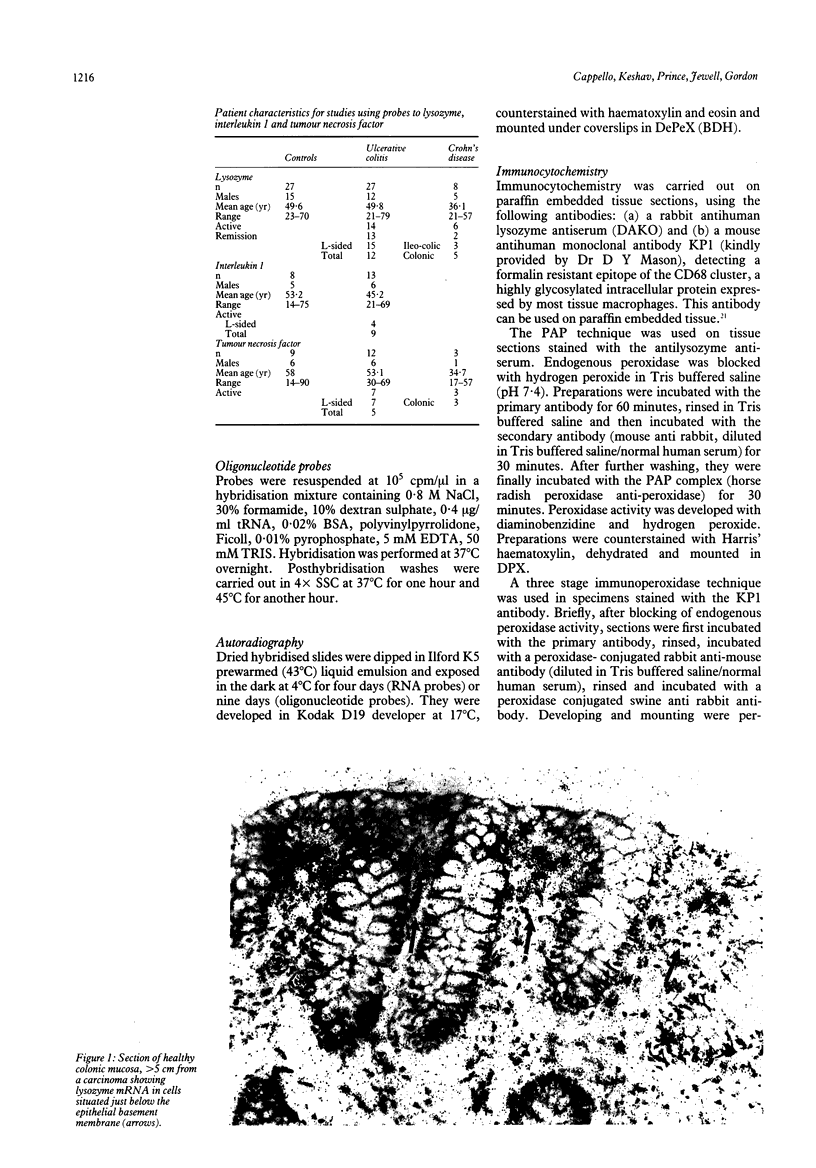
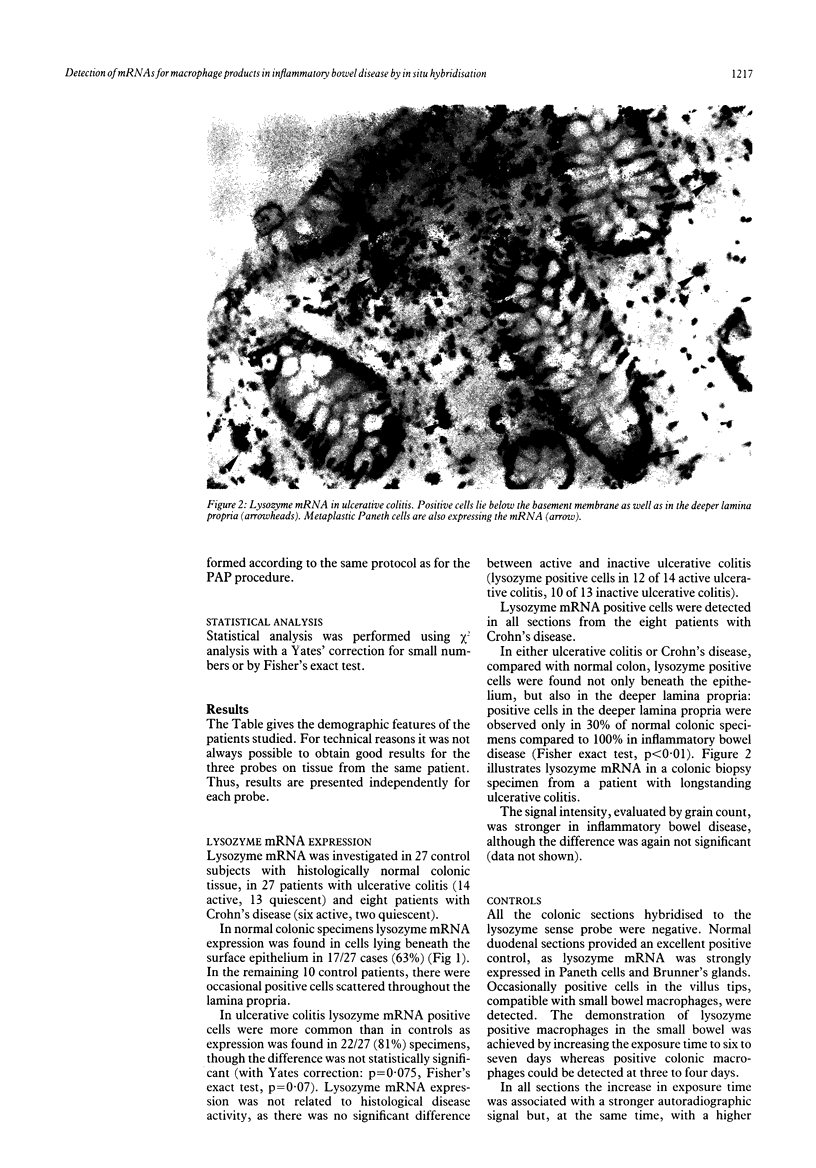
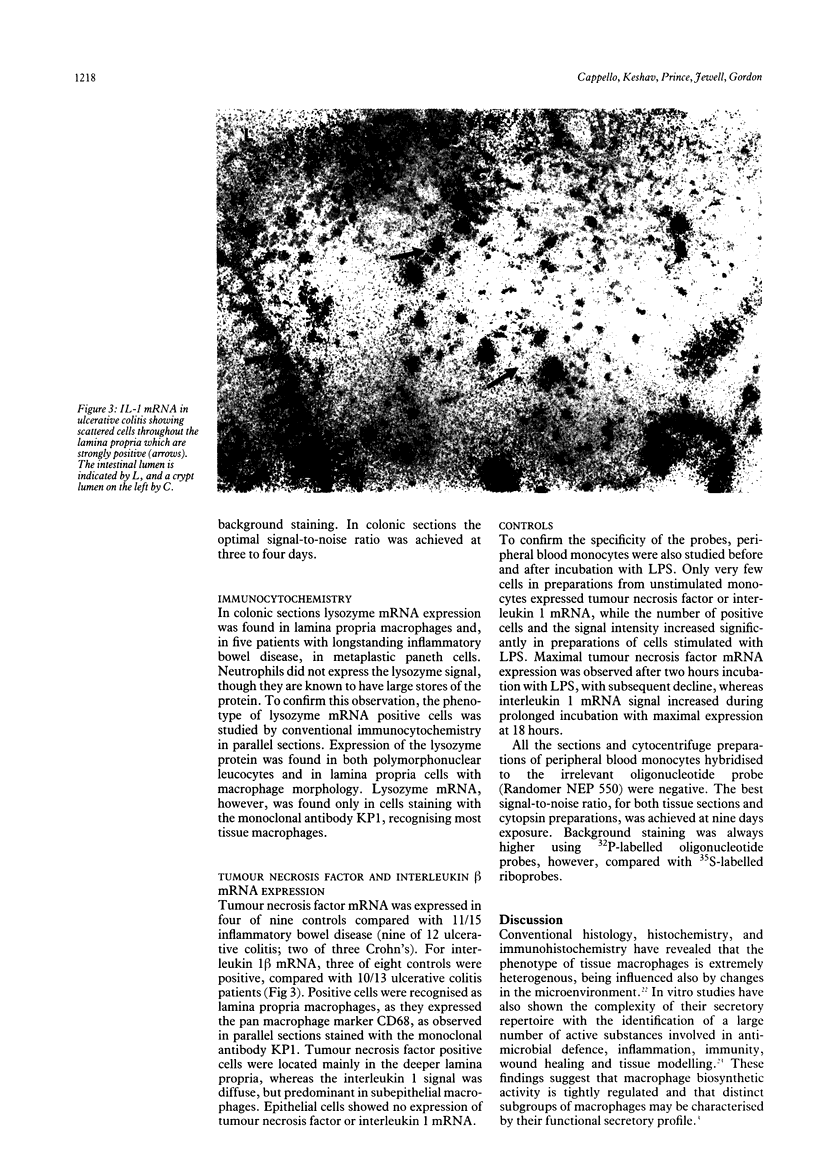
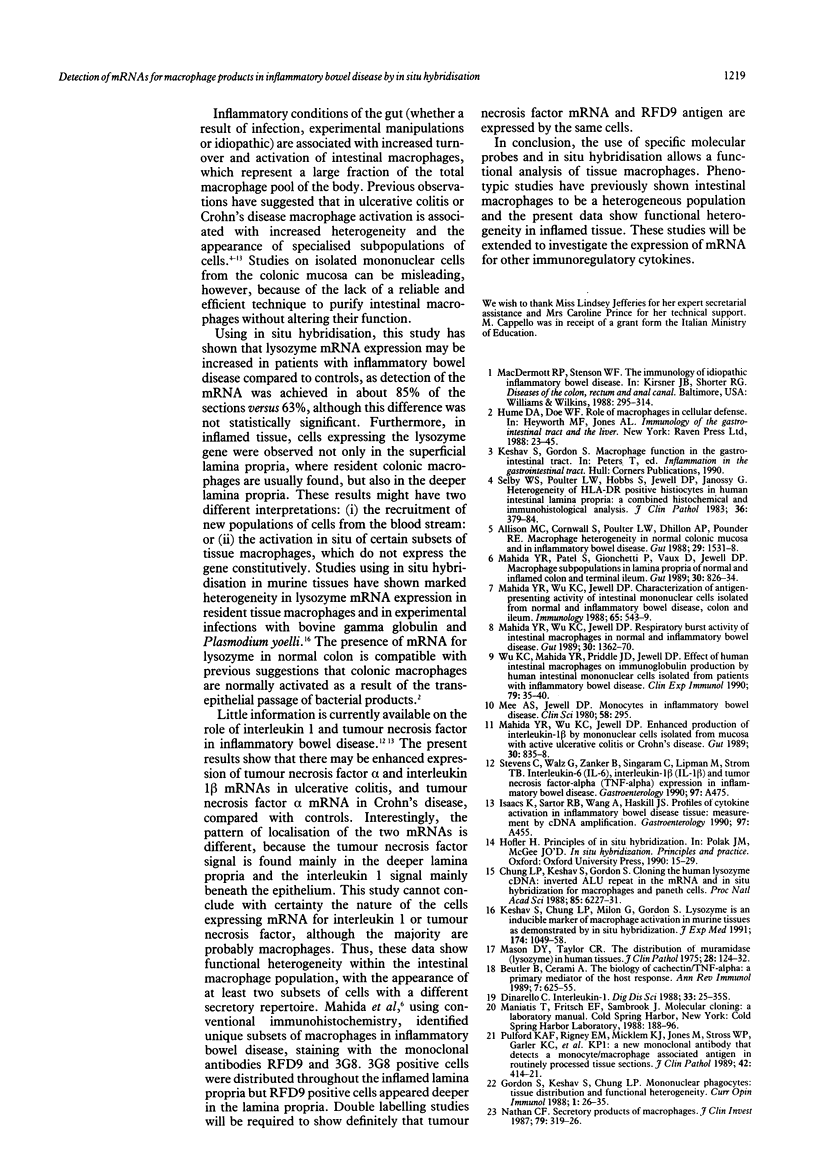
Images in this article
Selected References
These references are in PubMed. This may not be the complete list of references from this article.
- Allison M. C., Cornwall S., Poulter L. W., Dhillon A. P., Pounder R. E. Macrophage heterogeneity in normal colonic mucosa and in inflammatory bowel disease. Gut. 1988 Nov;29(11):1531–1538. doi: 10.1136/gut.29.11.1531. [DOI] [PMC free article] [PubMed] [Google Scholar]
- Beutler B., Cerami A. The biology of cachectin/TNF--a primary mediator of the host response. Annu Rev Immunol. 1989;7:625–655. doi: 10.1146/annurev.iy.07.040189.003205. [DOI] [PubMed] [Google Scholar]
- Chung L. P., Keshav S., Gordon S. Cloning the human lysozyme cDNA: inverted Alu repeat in the mRNA and in situ hybridization for macrophages and Paneth cells. Proc Natl Acad Sci U S A. 1988 Sep;85(17):6227–6231. doi: 10.1073/pnas.85.17.6227. [DOI] [PMC free article] [PubMed] [Google Scholar]
- Dinarello C. A. Interleukin-1. Dig Dis Sci. 1988 Mar;33(3 Suppl):25S–35S. doi: 10.1007/BF01538128. [DOI] [PubMed] [Google Scholar]
- Gordon S., Keshav S., Chung L. P. Mononuclear phagocytes: tissue distribution and functional heterogeneity. Curr Opin Immunol. 1988 Sep-Oct;1(1):26–35. doi: 10.1016/0952-7915(88)90047-7. [DOI] [PubMed] [Google Scholar]
- Keshav S., Chung P., Milon G., Gordon S. Lysozyme is an inducible marker of macrophage activation in murine tissues as demonstrated by in situ hybridization. J Exp Med. 1991 Nov 1;174(5):1049–1058. doi: 10.1084/jem.174.5.1049. [DOI] [PMC free article] [PubMed] [Google Scholar]
- Mahida Y. R., Patel S., Gionchetti P., Vaux D., Jewell D. P. Macrophage subpopulations in lamina propria of normal and inflamed colon and terminal ileum. Gut. 1989 Jun;30(6):826–834. doi: 10.1136/gut.30.6.826. [DOI] [PMC free article] [PubMed] [Google Scholar]
- Mahida Y. R., Wu K. C., Jewell D. P. Characterization of antigen-presenting activity of intestinal mononuclear cells isolated from normal and inflammatory bowel disease colon and ileum. Immunology. 1988 Dec;65(4):543–549. [PMC free article] [PubMed] [Google Scholar]
- Mahida Y. R., Wu K. C., Jewell D. P. Respiratory burst activity of intestinal macrophages in normal and inflammatory bowel disease. Gut. 1989 Oct;30(10):1362–1370. doi: 10.1136/gut.30.10.1362. [DOI] [PMC free article] [PubMed] [Google Scholar]
- Mahida Y. R., Wu K., Jewell D. P. Enhanced production of interleukin 1-beta by mononuclear cells isolated from mucosa with active ulcerative colitis of Crohn's disease. Gut. 1989 Jun;30(6):835–838. doi: 10.1136/gut.30.6.835. [DOI] [PMC free article] [PubMed] [Google Scholar]
- Mason D. Y., Taylor C. R. The distribution of muramidase (lysozyme) in human tissues. J Clin Pathol. 1975 Feb;28(2):124–132. doi: 10.1136/jcp.28.2.124. [DOI] [PMC free article] [PubMed] [Google Scholar]
- Mee A. S., Jewell D. P. Monocytes in inflammatory bowel disease: monocyte and serum lysosomal enzyme activity. Clin Sci (Lond) 1980 Apr;58(4):295–300. doi: 10.1042/cs0580295. [DOI] [PubMed] [Google Scholar]
- Nathan C. F. Secretory products of macrophages. J Clin Invest. 1987 Feb;79(2):319–326. doi: 10.1172/JCI112815. [DOI] [PMC free article] [PubMed] [Google Scholar]
- Pulford K. A., Rigney E. M., Micklem K. J., Jones M., Stross W. P., Gatter K. C., Mason D. Y. KP1: a new monoclonal antibody that detects a monocyte/macrophage associated antigen in routinely processed tissue sections. J Clin Pathol. 1989 Apr;42(4):414–421. doi: 10.1136/jcp.42.4.414. [DOI] [PMC free article] [PubMed] [Google Scholar]
- Selby W. S., Poulter L. W., Hobbs S., Jewell D. P., Janossy G. Heterogeneity of HLA-DR-positive histiocytes in human intestinal lamina propria: a combined histochemical and immunohistological analysis. J Clin Pathol. 1983 Apr;36(4):379–384. doi: 10.1136/jcp.36.4.379. [DOI] [PMC free article] [PubMed] [Google Scholar]
- Wu K. C., Mahida Y. R., Priddle J. D., Jewell D. P. Effect of human intestinal macrophages on immunoglobulin production by human intestinal mononuclear cells isolated from patients with inflammatory bowel disease. Clin Exp Immunol. 1990 Jan;79(1):35–40. doi: 10.1111/j.1365-2249.1990.tb05123.x. [DOI] [PMC free article] [PubMed] [Google Scholar]





